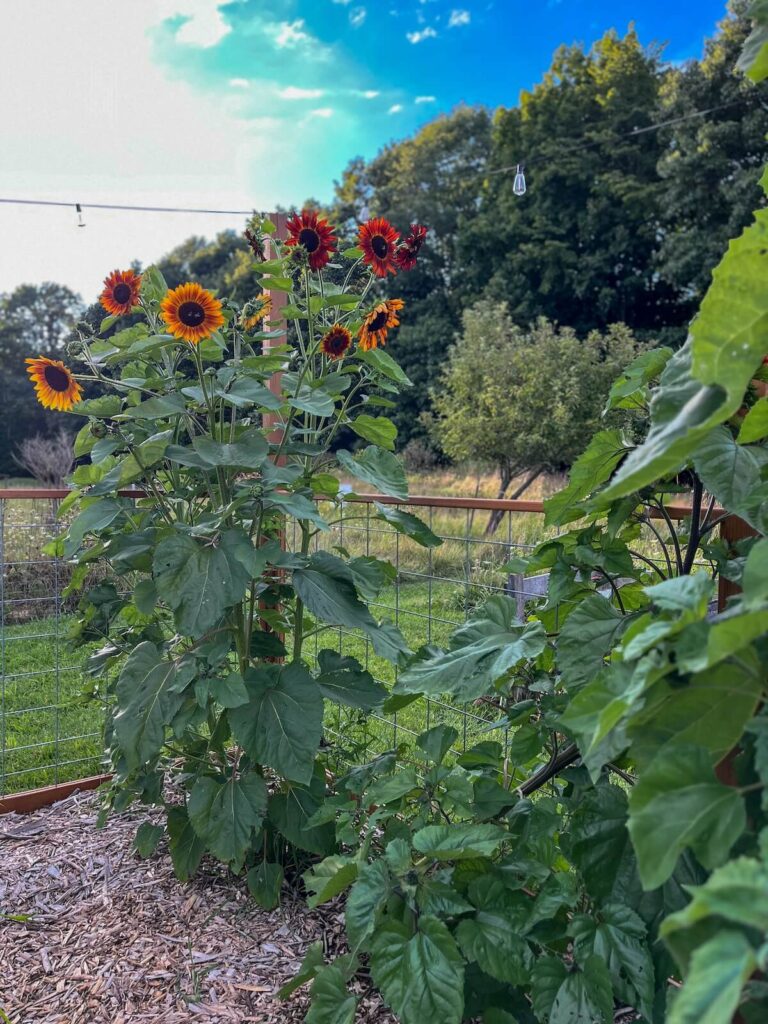How to Dry Cherry Tomatoes – (Super Easy Dehydrator Method)
Drying cherry tomatoes is quite possibly the best way to capture that delicious, sweet summer tomato flavor and preserve it all year long. This time of year, we have bowls full of fresh cherry tomatoes coming in from the garden every day. Drying—or dehydrating—them is a simple process that only takes about 20 minutes of hands on time, takes up minimal storage space, and captures the taste of summer to put in all sorts of dishes, from salads and pizzas to pasta or rice recipes. Find out how to dry cherry tomatoes in large or small batches with this super easy recipe.
This post contains affiliate links, which means that we make a small commission at no extra cost to you. You can view our full disclosure here.
Why Dehydrate Cherry Tomatoes?
Why dehydrate your tomatoes over other methods like canning or freezing? Here are a few reasons I love dehydrating tomatoes instead. (P.S. You can dry larger varieties of tomatoes too—keep reading to find out how!)
Side note: Dehydrated tomatoes, dried tomatoes, and sun-dried tomatoes are all the same product. You may hear these terms used interchangeably. The sun is the original dehydrator, but many people use electric dehydrators nowadays with a very similar results.
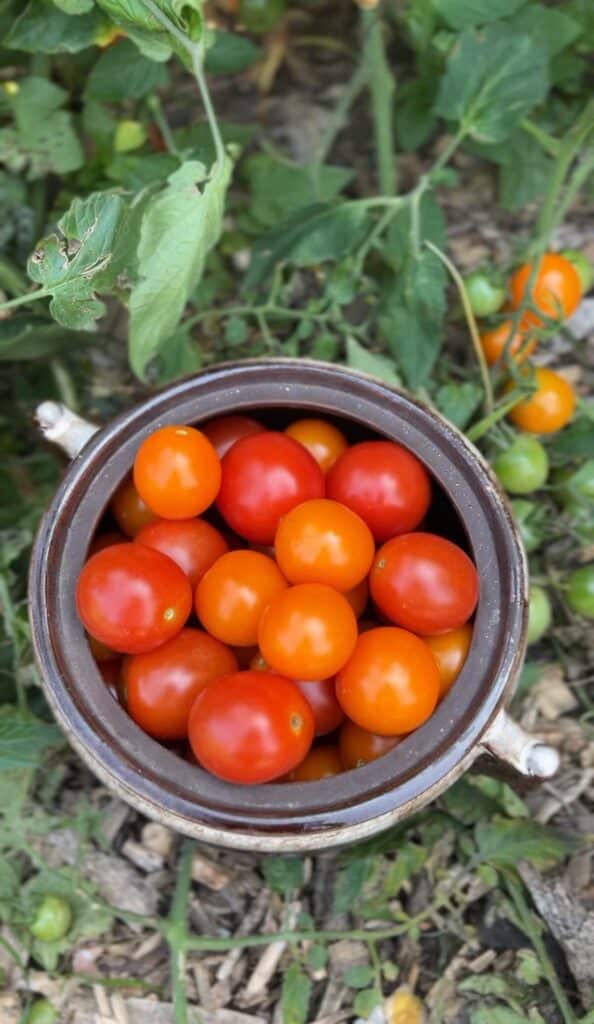
- Small-batch friendly. You don’t need 20lbs of tomatoes for this recipe! One large bowl of fresh cherry tomatoes will make a good amount of dried tomatoes. For us, one “batch” (or large bowl) is enough to last for 5 or so meals. So just make small batches as your garden gives them!
- Minimal storage space required. You don’t need lots of shelf space for storing jars. My favorite way to store these is in large plastic freezer bags in the freezer. They’re small and don’t take up much space compared with sauces and other tomato recipes.
- Minimal special equipment needed. We use a Nesco food dehydrator, which you can buy for $75 or less on Amazon. While there’s a bit of an initial investment, it’s no more than canning supplies, and there’s virtually no ongoing cost (such as additional jars and lids).
- They’re very forgiving. Dehydrating is a very simple process that’s honestly hard to mess up.
- Way cheaper than store-bought. Buying sun-dried tomatoes from the store is SO expensive! When you make them yourself (especially if you have your own cherry tomato plants), they cost just pennies!
- They’re delicious! Dehydrated tomatoes are like bottling up (or, bagging up!) the taste of summer—they’re sweet, chewy, delicious, and full of flavor!
How to Use Dried Tomatoes in Recipes
You might be surprised at how many dishes benefit from a handful of dehydrated cherry tomatoes! Here are a few of our favorite ways to eat them:
- Green salads. Add them to your green salad with some grilled chicken, mozzarella, and croutons, and you have a delicious meal!
- Pasta salads. Dehydrated tomatoes make a great addition to pasta salad. Add some cheese, pesto, olives, and fresh basil!
- Pizza. We love sprinkling them on homemade pizzas. Blue cheese and bacon is our favorite! Make sure you add them right at the end or they will burn in the oven.
- Rice dishes. One of our favorite recipes is Chickpeas and Rice.
- Sandwiches. Tuck them into grilled sandwiches for a hint of sweetness.
- Omelettes. Chop them up to add a lot of flavor to omelettes and other breakfast foods.
- Plain. My kids would eat a whole bag of dried tomatoes if I let them!
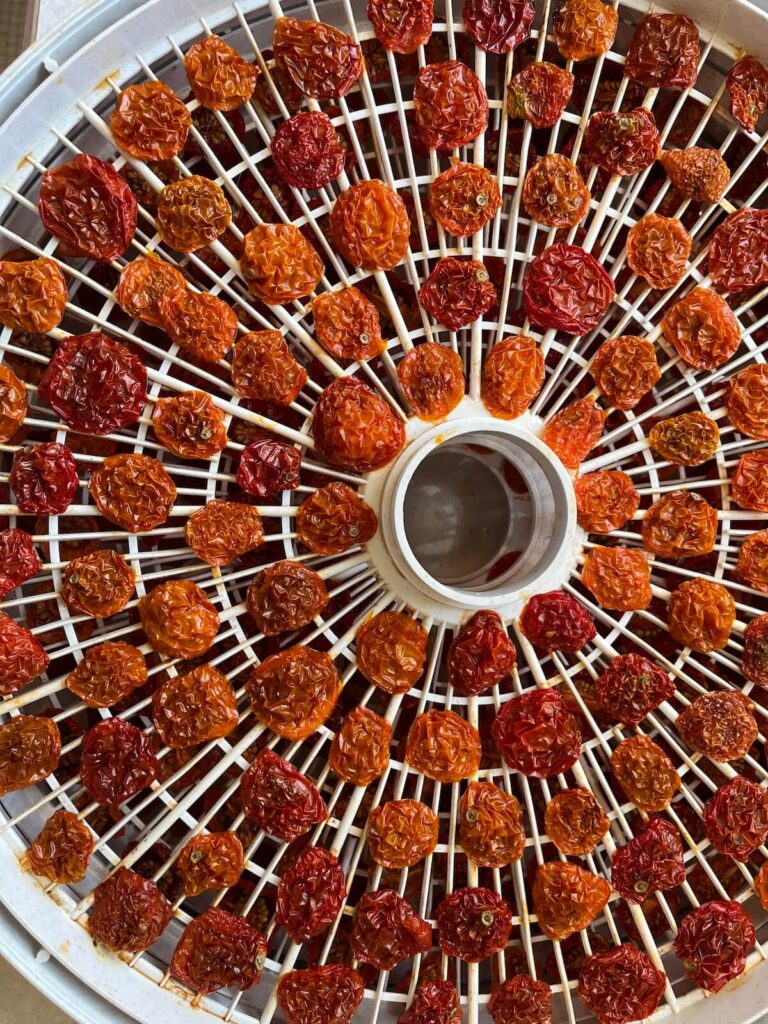
What Do Dried Tomatoes Taste Like?
Dried tomatoes are sweeter than regular tomatoes, with a chewier texture. A longer drying time will yield a slightly crunchier texture. The flavor of the tomatoes will also be affected by the variety you use, of course. A sweet tomato like sungold will yield a sweeter dehydrated tomato.
Can You Make Sun-Dried Tomatoes With Larger Tomato Varieties?
Yes! You can dry nearly all types of tomatoes, including plum tomatoes, grape tomatoes, roma tomatoes, or slicing tomatoes. For best results, group the same size tomatoes together in your dehydrator so they all finish at the same time. Larger tomatoes may be more difficult to remove from dehydrator trays than cherry tomatoes, since they’re often juicer.
After drying, break your larger tomatoes into pieces if desired.
How to Dry Cherry Tomatoes
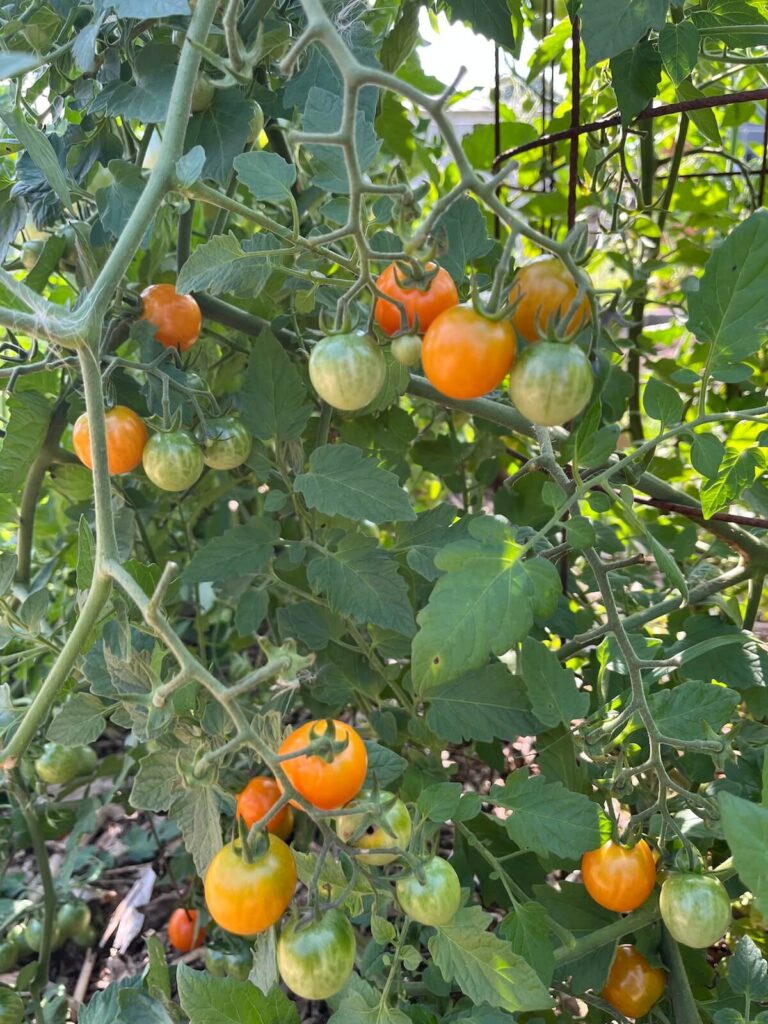
1. Prep Your Tomatoes
Start by picking ripe, healthy tomatoes without cracks. Wash them and slice tomatoes in half using a serrated knife (to avoid squishing).
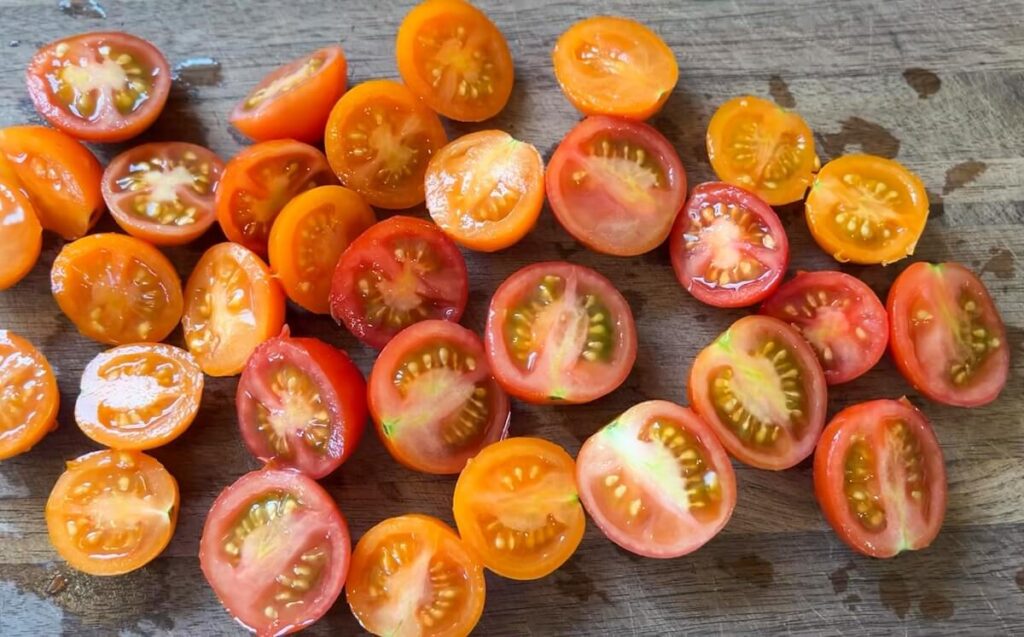
We dry out tomatoes just plain—they are packed with flavor as is!—but you can also dunk them in some extra virgin olive oil, italian seasoning, garlic cloves, sea salt, or other fresh herbs before dehydrating if you like.
2. Spread on Dehydrator Trays
Next, lay the cherry tomato halves on your dehydrator tray in a single layer. (Cut sides up or down—I haven’t really noticed a difference in how they turn out.) Make sure they’re not stacked on top of each other or they won’t get as much air circulation and therefore won’t dry as evenly.
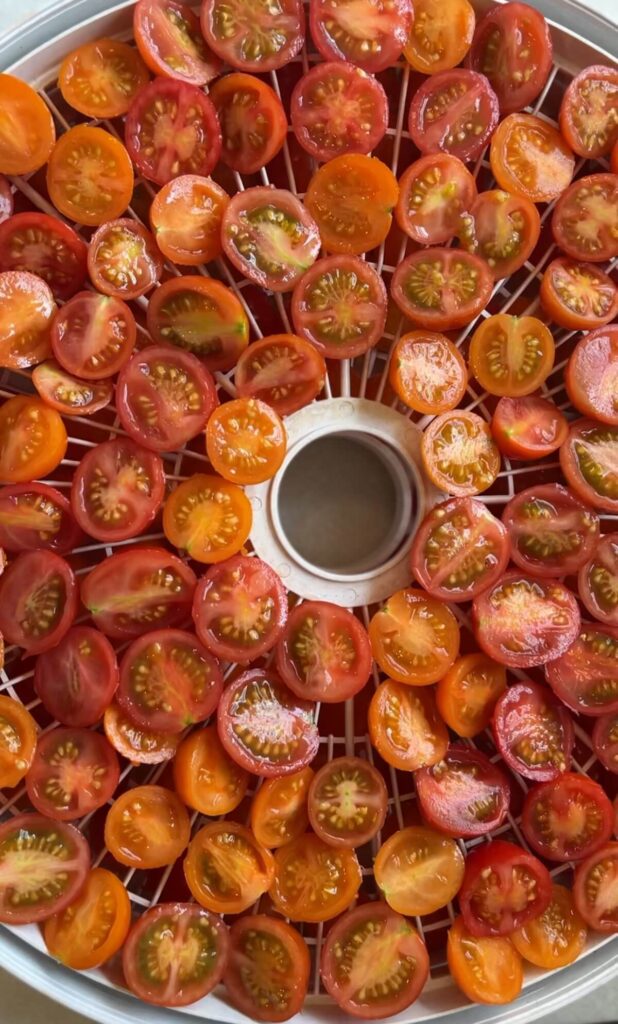
(Note: you can also use the oven method to make oven-dried tomatoes. Simply lay your cut tomatoes on a parchment-lined baking sheet and bake at 250°F for 2-4 hours, checking often to make sure they don’t burn. This method is a little more hands on than using a food dehydrator.)
3. Dry for 8-16 Hours
Dry tomatoes in the dehydrator for approximately 8-16 hours at 135°F. I find that 12-14 hours of drying time is typically sufficient for small tomatoes. Larger varieties may require more time. I turn the dehydrator on overnight and check them in the morning. This method is very forgiving, so if they still seem a bit squishy, just turn them back on for a couple more hours.
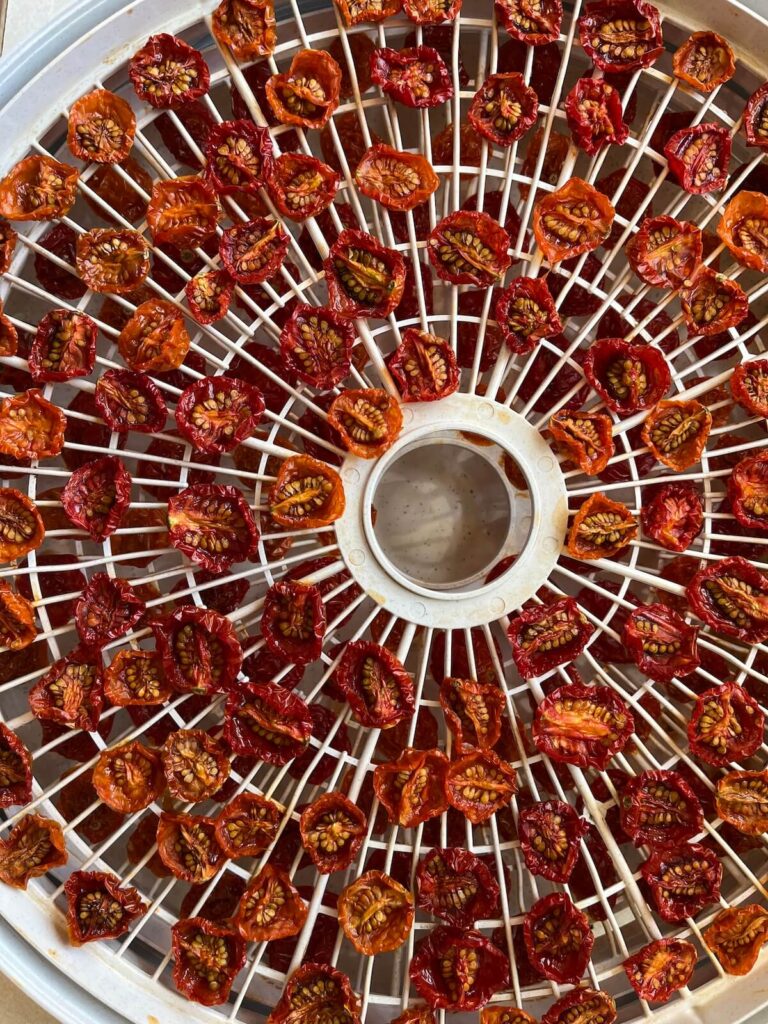
4. Remove and Freeze
When they’re as crisp as you like them, remove and throw in plastic freezer bags in the freezer for long term storage. This is my favorite method, and I’ve stored them for up to 2 years this way. They don’t take up much space and I don’t have to worry about mold or other issues from excess moisture. Plus, they thaw in just minutes. (And if you can sneak a few while they’re still slightly frozen, they’re deliciously crispy!)
You could also opt to store them at room temperature in an airtight container like large jars. While thoroughly dehydrated foods can technically store up to a year, you’ll want to make sure they’re adequately dry and check them periodically to make sure there’s not moisture or bacteria growing in the jar.
Favorite Cherry Tomato Varieties
What are the best tomatoes for dehydrating? Some of my favorite tomatoes to grow and dry include:
- Sungold
- Citrine
- Cherry Bomb
- Black Cherry
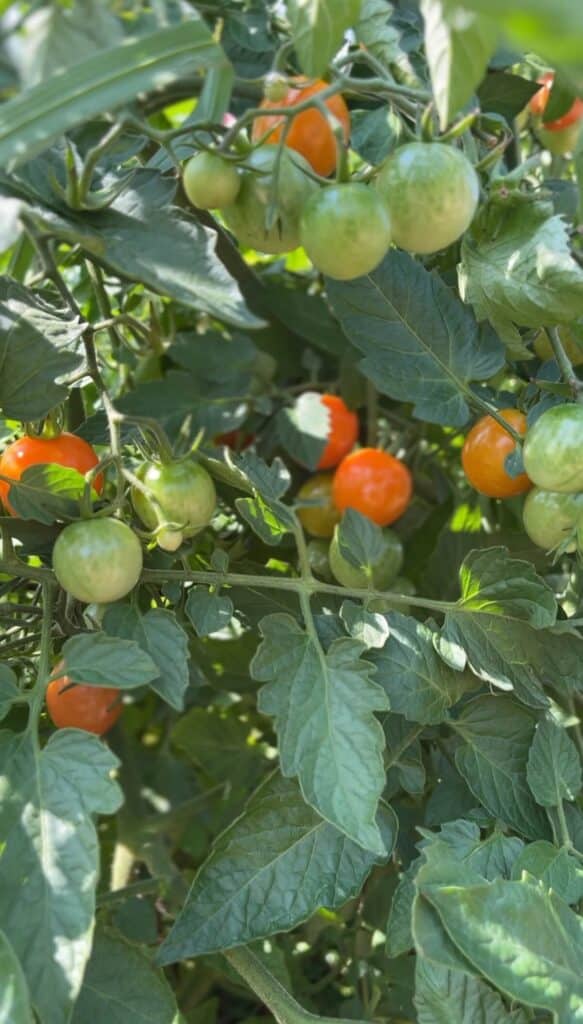
FAQs
What Are Sun-Dried Tomatoes?
Sun-dried tomatoes are tomatoes that have been dehydrated—or had their juice removed—by the heat of the sun, a food dehydrater, an oven, or another heat source. Drying is typically accomplished by heating at a low temperature for at least a few hours.
Can You Make Tomato Powder With Sun-Dried Tomatoes?
If you dehydrate your tomatoes long enough that they’re brittle, you can then grind them up in a food processor to make tomato powder. Store your powder in air-tight containers in the fridge until you’re ready to use. When you run out of tomato sauce, tomato paste, or tomato soup in the middle of winter, just rehydrate the powder and you’re ready to go!
It’s a great way to preserve the freshness of summer that’s also versatile and doesn’t take up much space.
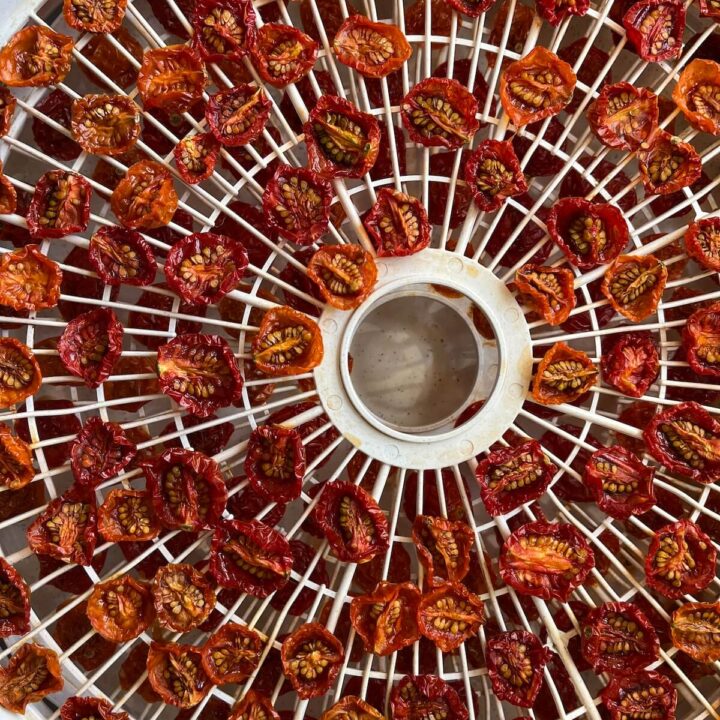
How to Dry Cherry Tomatoes
Drying cherry tomatoes is quite possibly the best way to capture that delicious, sweet summer tomato flavor and preserve it all year long. All you need is a dehydrator, some tomatoes, a cutting board, and a serrated knife.
Ingredients
- Cherry tomatoes
- Dehydrator
Instructions
- Start by picking ripe, healthy tomatoes without cracks. Wash them and slice tomatoes in half using a serrated knife (to avoid squishing).
- Next, lay the cherry tomato halves on your dehydrator tray in a single layer. (Cut sides up or down—I haven’t really noticed a difference in how they turn out.)
- Dry tomatoes in the dehydrator for approximately 8-16 hours at 135°F. I find that 12-14 hours of drying time is typically sufficient for small tomatoes. Larger varieties may require more time. I turn the dehydrator on overnight and check them in the morning. This method is very forgiving, so if they still seem a bit squishy, just turn them back on for a couple more hours.
- When they’re as crisp as you like them, remove and throw in plastic freezer bags in the freezer for long term storage (up to 2 years).
Notes
We use a Nesco dehydrator.
You can also dehydrate larger tomatoes! You may need to adjust the drying time. If desired, break them into smaller pieces once they're dry.
Unlike canning, dehydrating is small-batch friendly! Dry one bowl of tomatoes or many!



